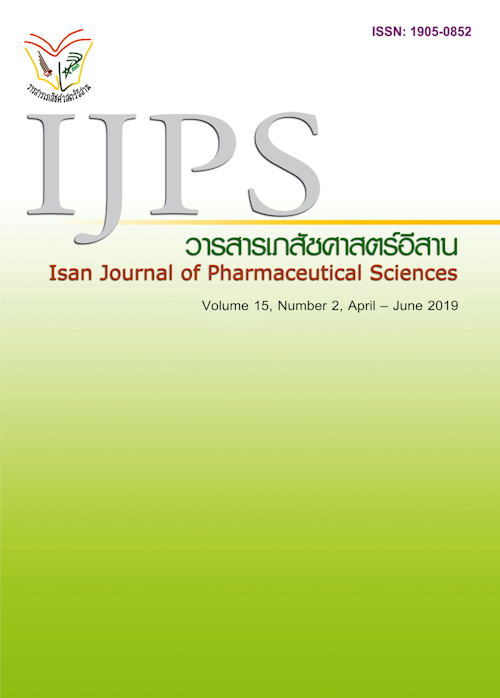Associations between Antibiotic Use and Resistance in Mahasarakham Hospital
Main Article Content
Abstract
Introduction: Antibiotic resistance is a worldwide public health problem as it increases mortality rate and health care expenditures. A number of factors associated with antibiotic resistance including habits of healthcare personnel, referral system of infected patients and overuse of antibiotics. The objective of this study is to determine associations between antibiotic use and resistance in Mahasarakam hospital. Methods: A retrospective study was conducted using electronic database and antibiogram between 2010 and 2017. Antibiotic use was measured as defined daily dose (DDD). Antibiotic resistance was percentage of reported antibiotic susceptibility as intermediate susceptible or resistance. Trends of antibiotic use, positive culture and antibiotic resistance were analyzed using linear regression. Pearson’s correlation was used to determine associations between antibiotic use and resistance. Results: Between 2010 and 2017, antibiotic use increased from 96.12 DDD/100 patient-days to 111.65 DDD/100 patient-days (p=0.019). Increased carbapenem resistance was found in E.coli and K.pneumoniae (from 1% to 8%, p=0.002 and from 1% to 16%, p=0.001, respectively) and cefoperzone/sulbactam resistance increased in A.baumannii (from 72% to 89%, p=0.004). Carbapenem use was correlated to carbapenem-resistant rate of E.coli (r=0.74, p=0.034) and K.pneumoniae (r=0.79, p=0.019), and correlated to MRSA detection (r=0.844, p=0.008). There was no association between cabapenem use and rate of carbapenem-resistant A.baumannii (r=0.56, p=0.149) and P.aeruginosa (r=-0.07, p=0.862). Piperacillin/tazobactam use was associated with ESBL positive detection (r=-0.74, p=0.037) but not associated with piperacillin/tazobactam-resistant P.aeruginosa rate (r=0.35, p=0.435). Vancomycin use was not associated with vancomycin-resistant E.faecium rate (r=0.10, p=0.904). Discussion and Conclusion: Increases in carbapenems use was associated with Enterobacteriaceae resistance and increase in piperacillin/tazobactam was associated with ESBL producing strain. The hospital should strengthen antibiotic stewardship program to reduce and control antimicrobial resistance.
Article Details
In the case that some parts are used by others The author must Confirm that obtaining permission to use some of the original authors. And must attach evidence That the permission has been included
References
Friedman ND, Temkin E, Carmeli Y. The negative impact of antibiotic resistance. ClinMicrobiol Infect. 2016;22(5):416-22.
Granov D, Ljubovic AD, Zec SL, Granov N, Hukic M. The Impact of Antibiotic Consumption on Development of Acinetobacter baumannii Resistance. Mater Sociomed. 2016;28(6):449-53.
Goossens H. Antibiotic consumption and link to resistance. ClinMicrobiol Infect. 2009; 15(Suppl 3):12-5.
Hongchumpae O, Santimareeworagun W. The Correlation between Defined Daily Dose/1000 Patient-day of Antimicrobials and the Resistance Rate of P.aeruginosa and A.baumannii: A Case Study at Hua-Hin Hospital. Thai Pharm Health Sci J. 2016;11(1):27-32.[in Thai].
La-ongsuwan S, Jaemsak K, Chor.soraphong T, Kaewbutra V, Laosuebsakhunthai W. Correlation between the Antimicrobials Utilization and Antimicrobial-Resistance in Prasat Neurological Institute. Thai Bull Pharm Sci. 2017;12(2): 21-9.[in Thai].
Lee HS, Loh YX, Lee JJ, Liu CS, Chu C. Antimicrobial consumption and resistance in five gram-negative bacterial species in a hospital from 2003 to 2011. J MicrobiolImmunol Infect. 2015;48(6):647-54.
Mascarello M, Simonetti O, Knezevich A, Carniel LI, Monticelli J, Busetti M, Schincariol P, Torelli L, Luzzati R. Correlation between antibiotic consumption and resistance of bloodstream bacteria in a University Hospital in North Eastern Italy, 2008-2014. Infection. 2017;45(4):459-67.
McLaughlin M, Advincula MR, Malczynski M, Qi C, Bolon M, Scheetz MH. Correlations of Antibiotic Use and Carbapenem Resistance in Enterobacteriaceae. Antimicrob Agents Chemother. 2013; 57(10): 5131-3.
Miller AD, Ball AM, Bookstaver PB, Dornblaser EK, Bennett CL. Epileptogenic potential of carbapenem agents: mechanism of action, seizure rates, and clinical considerations.Pharmacotherapy. 2011;31(4):408-23.
Naylor NR, Atun R, Zhu N, Kulasabanathan K, Silva S, Chatterjee A, Knight GM, Robotham JV. Estimating the burden of antimicrobial resistance: a systematic literature review. Antimicrob Resist Infect Control. 2018 Apr 25;7:58. doi: 10.1186/s13756-018-0336-y. eCollection 2018.
National Antimicrobial Resistant Surveillance Center, Thailand. Antimicrobial Resistance rates of Acinetobacter spp. by year. 2016. [online]. [cited 2018 Mar 11]. Available form https://narst.dmsc.moph.go.th/data/AMR%202000-2016.pdf.2561.[in Thai].
Peterson LR. Squeezing the antibiotic balloon: the impact of antimicrobial classes on emerging resistance. ClinMicrobiol Infect. 2005;11 Suppl.5:4-16.
Sumpradit N, Suttajit S, Poonplosup S, Chuancheun R, Prakongsai P. Landscape of antimicrobial resistance situations and actions in Thailand. Bangkok: Aksorn graphic and design publishers; 2015. [in Thai].
WHO Collaborating Center for Drug Statistic Methodology. ATC/DDD Index [Online]. [cited 2018 Dec 13]. Available from: https://www.whocc.no/atc_ddd_ index/


